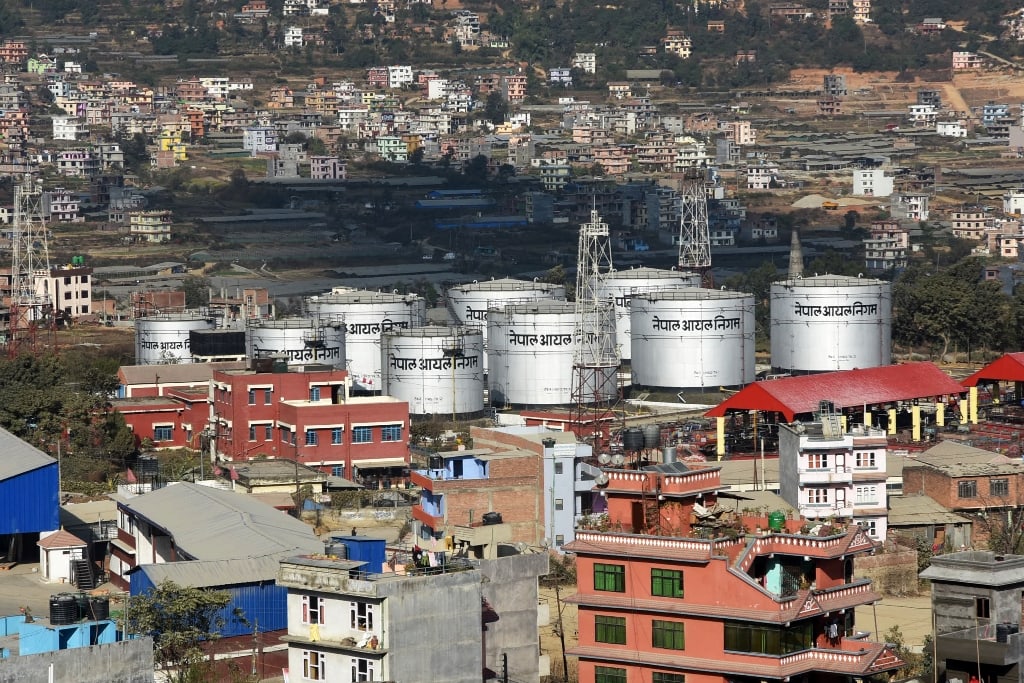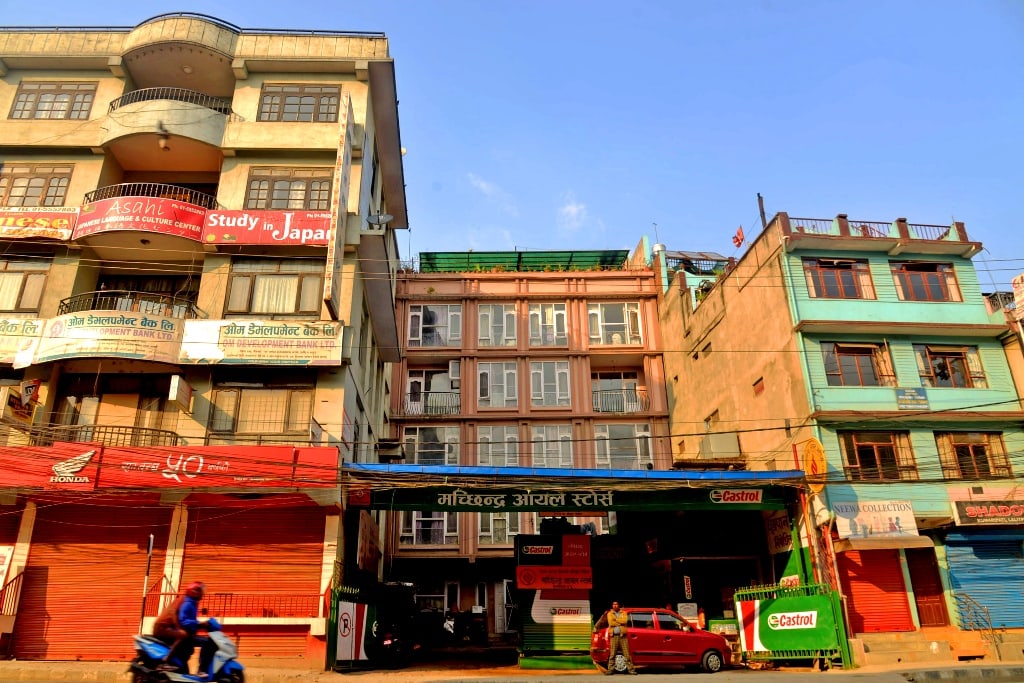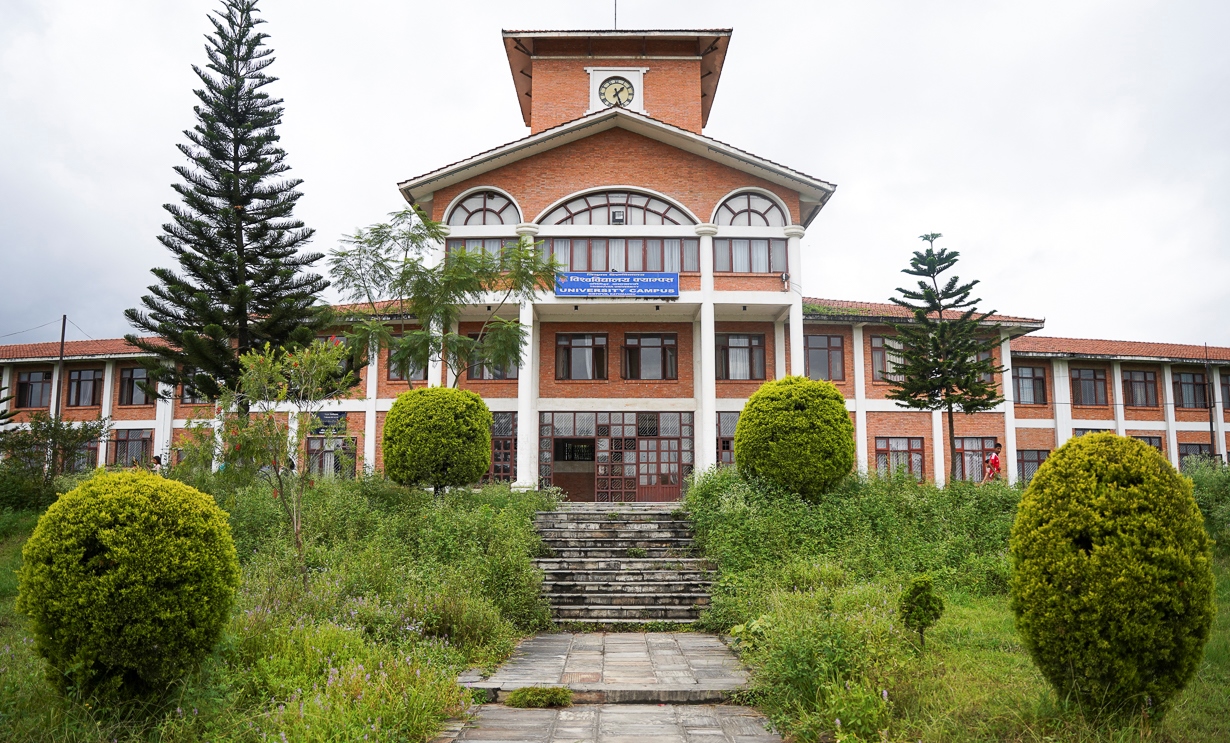Most fuel stations in Kathmandu, home to an estimated four million people, are dangerously located around densely populated areas, often close to road and houses. Are we awaiting a catastrophic disaster?
Bhadra Sharma: Centre for Investigative Journalism-Nepal
Kota: Dhuku Petrol Pump is just a few meters walk from Balaju Chowk towards Sorhakhutte. Two dispensers for petrol and diesel adjoin the footpath, as the retailer does not have a compound. The station’s fuel container lies on the ground floor of a three-storey house.

Thankot Depot. Photo Courtesy: Ashok Dulal
At the authorised dealer of Nepal Oil Corporation, a distributor comes on the road with the nozzle in hand to serve motorists. Clients stop vehicles on the busy road for refuelling. During office hours, their long queue causes a traffic bottleneck along the Balaju-Sorhakhutte road, which looks wet with fallen droplets of the flammable petrol and diesel.
The facility has no space for essential firefighting tools in case of a disaster. They have not adopted any mechanism to minimise potential hazards. Neither are there necessary infrastructure and safety measures in place.
This poses a threat to the lives of pedestrians and people living in the surroundings. The NOC had instructed Kota: Dhuku Petrol Pump to shut its business on multiple occasions for “operating in a risky manner sans proper infrastructure”. The instructions were not heeded.
Instead, the owner Uttam Das Manandhar moved the Supreme Court claiming that he faced great injustice as the government encroached upon his land during road expansion. The court then instructed the authorities “not to remove the petrol station for now”. And the NOC quietly backed off.
![]()
Opposite Kota-Dhuku Petrol Pump lies another company, Chakrapath Fuel Center. According to the NOC, Ramnath Dangol opened it in 1990 by installing a fuel dispenser a few feet away from the road. Also a victim of the road expansion drive, the station is operating without a compound. There are a shop and a motorcycle workshop on its premises.
![]()
Many other petrol pumps in Kathmandu Valley are no different from the aforementioned ones. To name a few, Kanak Trade Concern along the busy Teku-Kalimati road section, Shyama Oil at Kalanki Chowk and Gayatridevi Oil Stores in Ekantakuna are operating on the roadside.
Adjoining Gayatridevi Oil Stores is an auto repair company called GS Workshop and Auto Parts. They frequently weld metal. In the process, its sparks can travel far and pose a significant threat of fire when in contact with inflammable materials including fuel readily available at the filling station.
Commuters around the petrol station waiting for vehicles idle around with cigarettes in their hand. Nearby electric wires equally pose the risk of a short circuit. Yet, there is no water tank and necessary infrastructure to control potential hazards. Firefighters say the arrangements “are not sufficient to prevent damage in case of a disaster”.
![]()
SP International Ink Petrol Pump along the Jawalakhel-Pulchowk road is also located by the roadside. There is a motorcycle workshop nearby with the name UD Modern Design. Electric wires hang above the petrol station. And there are no security personnel to stop intentional and unintentional acts of carelessness from anybody.
Sajha Petrol Pump at Pulchowk has set up fences to prevent unauthorized people from entering and also made efforts to manage the electricity wires. But with a transformer nearby and wires still present, they are not free of risk.
The traffic-heavy area of Balaju-Chakrapath has one petrol station every one kilometer stretch. Due to the location of one in a densely populated area and in close proximity with a party palace where there are regular public gatherings, this petrol station becomes unsafe.
(See:Geographical infographics of petrol pumps in valley) For detailed description, hover over pump’s icon in map and click. ![]()
Manjushree Petrol Pump at Lagankhel, Lalitpur, is yet another example of unsafe fuel dispensing. Its signboard hangs away on the wall but the pump is located in the middle of road where consumers wait for fuel on either side.
Danger looms along the Satdobato-Jawalakhel road section as well. Although Shanti Devi Petrol Pump operated by the Nepal Army seems trading fuel with relative safeguards, other pumps situated either in congested areas or along the road flout safety measures.
Mahayan Petrol Pump and Machhindra Pump of Kumaripati are dealing in highly flammable liquids in crowded locations, that too without compounds, running greater risks.
If such stations are not brought under regulation, Valley residents could face another major disaster any time, according to employees at the Metropolitan Emergency Operation Center (MEOC).
“Areas around petrol pumps are risky zones in themselves. As they are operating in densely populated areas of the Valley without ability to minimize risks, these filling stations have become no different from landmine,” said MEOC chief Kishor Kumar Bhattarai.
Although locals are well aware of the risks, stakeholders do not worry about them unless there are major accidents. Risk mitigation is nobody’s priority, complained Raju Tamrakar of Patan.
“If accidents happen, our society talks about it for a few days while bereaved families remember the victims once a year. But nobody bothers to prevent potential disasters.”
There are 123 fuel stations in Kathmandu, 29 in Lalitpur and 20 in Bhaktapur (add hyperlink), data maintained by the NOC show. The Corporation’s officials say pump operators are not concerned much about looming disasters and the need for safe trading of fuels. They have their own arguments about inaction in removing unsafe pumps. “Some fuel pumps were established following the old criteria for their operation. We are unable to replace them in accordance with the existing criteria,” said NOC Managing Director Surendra Paudel.
Each station normally stores at least 20 kiloliters (20,000 liters) of diesel and 12 kiloliters (12,000 liters) of petrol, as per the NOC’s criteria. This means that at any given time there are 3,440 kiloliters (3.4 million liters) of diesel and 2,064 kiloliter (2 million liters) of petrol stored underground in Kathmandu Valley.

Machindra Oil Store in corner of Kumaripati road.
The NOC’s depot at Thankot supplies 5,310 kiloliters of petrol, 8,400 kiloliters of diesel and 710 kiloliters of kerosene in the Valley. The aviation fuel depot at Sinamangal near the Tribhuvan International Airport stores 7,000 kiloliters of flammable material, according to the NOC. Officials say the Corporation maintains 90 percent of storage capacity.
Due to the huge quantities of diesel and petrol in store, the surrounding areas could face massive casualties in the even of a fire. It is a high time to review the conditions in these areas. The NOC has promised to install fire safety equipment at its depots in Sinamangal and Thankot.
“It is not possible to relocate our depots. But we have called bids to procure four new refuellers for the airport depot and 11 for other depots for safety reasons,” said MD Paudel.
These depots were built in thinly populated areas at one time. But due to urbanisation, these depots are being surrounded by dense settlements. Although the authorities claim to have adopted safety measures, residents of Thankot said they do not feel safe.
“There was no settlement around the depot previously. But after land plotting, we also started living here,” said Dinesh Gopali of Thankot. “We are afraid but what will fear achieve?”
Safety valve
The state owned supplier has formulated a safety directive for fuel stations so as to tackle potential disasters. However, stations operating in the Valley do not follow it. Even the measures outlined in the directive are not sufficient.
As per the directive, each petrol pump must compulsorily have four fire extinguishers weighing 10 kg each, four buckets of water, sand and gravel. However, these resources are not sufficient to control fuel station fires.
The MEOC also does not have a well-equipped fire brigade to fight big fires. “In such a situation, we cannot even imagine the loss from a fire outbreak,” said MEOC Chief Bhattarai.
Even implementation of the directive at the Valley’s petrol pumps is very weak due to the negligence of law enforcement bodies.
As per the 2016 directive of the NOC, there has to be at least one bigha (13 ropanis) land to operate a petrol station in the Tarai and inner Tarai areas (except in Udayapur, Chitwan, Makwanpur, Dang and hill areas of Surkhet) while the hilly and mountainous areas require five ropanis to set up a fuel dispensing facility.
Likewise, there must be a concrete compound of at least three feet and maximum five feet or cemented pillars with barbed wires on three sides where transactions of fuels take place. It also mentions the requirement of a canopy with around 18 meters and up to 30 meters of roof to cover the refuelling area, five toilets including one for disabled people, fire retardant system on the compound of fuel station, underground containers and mapping of its capacity and quantity and capacity to serve eight vehicles at once.
Despite formulating the directive by itself and having the responsibility for monitoring, the NOC has not enforced the criteria in the Valley’s petrol pumps. But NOC officials said none of the stations inside the Ring Road would be in operation if they enforced the safety criteria.
Playing with fire
Most of the petrol pumps of the Valley were in existence before the population grew significantly. But as the NOC revised the criteria over time, it became increasingly ‘impractical’ for the stations to implement the directives.

Gayatridevi Oil Store in the way from Ekantakuna Chowk to Bhainsepati road section.
The road expansion drive initiated in 2011 by then-prime minister Baburam Bhattarai brought many petrol pumps closer to the road. Kanak Trade Corners of Teku is a representative case.
As per the NOC criteria, distance between two petrol pumps must be at least 10 kilometers so as to prevent fire spreading between them. But many petrol pumps in the Valley are operating within a one-kilometer distance from each other. In case of fire, there could be dire consequences if the flames are not doused on time.
Underground containers for petroleum products should be away from human settlements and the trader should compulsorily build three to five feet of walls around the petrol station. Although many don’t meet the standards, NOC officials shrugged it off saying those stations were in existence before the criteria were set.
“The government should introduce a new Petroleum Act for proper management of petrol pumps. It is very difficult to manage from the NOC’s side,” said Tanka Kafle, deputy director of the NOC’s Monitoring Unit. “All we can do from our side is monitor safety measures while loading and unloading petroleum products from tankers.”
Deputy Managing Director Sushil Bhattarai says the road expansion drive in Kathmandu has encroached upon the land of most petrol pumps. Stating that the NOC cannot remove unsafe petrol pumps on its own, NOC Executive Director Paudel also called for parliamentarians to formulate separate laws. “We are just a company, not a regulatory body,” he added.
Many incidents have pointed out the risks of operating pumps in unsafe manner alongside roads. In November 2017, Alam Mechanical Workshop on the premises of the Tripureshwor-based Jayanti Oil Store caught fire, killing its employee Mulayam Miya.
Petrol pump owner Binod Jajuriya had rented space out to the workshop. When the fire started there, authorities were able to put it out timely, preventing it from catching nearby settlements.
Nonetheless, it also wounded two others–Muslim Miya, 25, and Aajid Miya, 12. Property worth millions of rupees was destroyed. According to Bhattarai, half a dozen petrol pumps had fire incidents earlier.
During the unofficial Indian embargo on Nepal starting in 2015, fire at a nearby office threatened the fuel pump run by Nepal Army. Only timely intervention of firefighters had saved it. The incident was not known to the public.
Comparatively, the Halchowk fuel pump of Nepal Police has bigger space. But it has already been victimised by the incidents of fire. One motorbike had burnt but timely intervention prevented further damage, according to a fireman.
On August 9, 2016, the Balkhu-based Dakshinkali Petrol Pump caught fire due to a short circuit. Three employees, a police official and a driver sustained injuries. In July 2017, the Lokanthali-based Siddhartha Petrol Pump also caught fire, injuring four people. It damaged property worth millions of rupees.
Syndicate of unsafe pumps
In 2019, NOC proposed relocating petrol pumps from congested areas and narrow spaces. However, the operators stand against the move, putting the plan in limbo for the past seven years.
“Customers are visiting unsafe pumps. Those who are operating ones without following the rules are not deterred,” said NOC Deputy Executive Director Bhattarai.
The government has long stopped providing licence to open new petrol pumps even if they are willing to fulfill the criteria. Bhattarai said he is in favour of granting licence to those who meet the criteria, but the syndicate of unsafe petrol pumps is against it. “And their lobby is prevailing,” he added.
But petrol pump owners have their own logic. They argue that since their land was encroached upon during road expansion, the government shouldn’t remove their pumps. “Obviously, safety issue comes when one runs a petrol pump. At that time, it was easily allowed to run a petrol pump if you had land,” said Achyut Bahadur Pandey, head of the Bagmati Petroleum Dealers Association. “If the government wants to remove them, compensation for the land should be given.”



